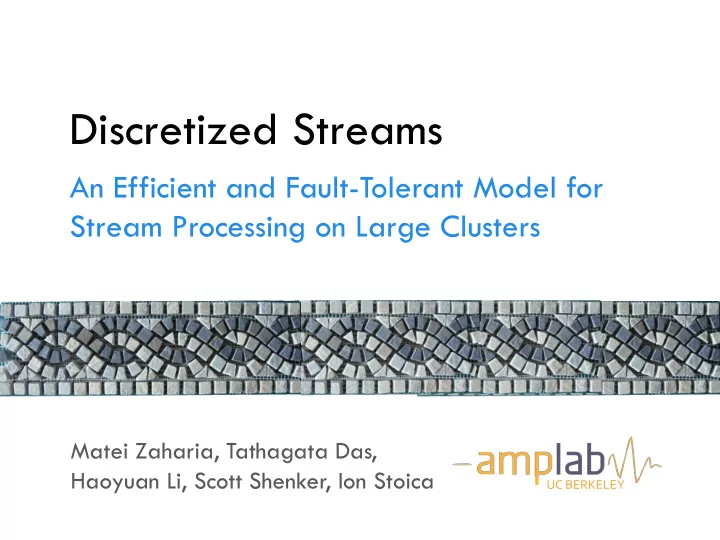

Discretized Streams An Efficient and Fault-Tolerant Model for Stream Processing on Large Clusters Matei Zaharia, Tathagata Das, Haoyuan Li, Scott Shenker, Ion Stoica UC ¡BERKELEY ¡
Motivation • Many important applications need to process large data streams arriving in real time – User activity statistics (e.g. Facebook’s Puma) – Spam detection – Traffic estimation – Network intrusion detection • Our target: large-scale apps that must run on tens-hundreds of nodes with O(1 sec) latency
Challenge • To run at large scale, system has to be both: – Fault-tolerant: recover quickly from failures and stragglers – Cost-efficient: do not require significant hardware beyond that needed for basic processing • Existing streaming systems don’t have both properties
Traditional Streaming Systems • “Record-at-a-time” processing model – Each node has mutable state – For each record, update state & send new records mutable state input records push node 1 node 3 input records node 2
Traditional Streaming Systems Fault tolerance via replication or upstream backup : input node 1 input node 1 node 3 node 3 input node 2 input node 2 synchronization node 1’ standby node 3’ node 2’
Traditional Streaming Systems Fault tolerance via replication or upstream backup : input node 1 input node 1 node 3 node 3 input node 2 input node 2 synchronization node 1’ standby node 3’ Fast recovery, but 2x Only need 1 standby, node 2’ hardware cost but slow to recover
Traditional Streaming Systems Fault tolerance via replication or upstream backup : input node 1 input node 1 node 3 node 3 input node 2 input node 2 synchronization node 1’ standby node 3’ node 2’ Neither approach tolerates stragglers
Observation • Batch processing models for clusters (e.g. MapReduce) provide fault tolerance efficiently – Divide job into deterministic tasks – Rerun failed/slow tasks in parallel on other nodes • Idea: run a streaming computation as a series of very small, deterministic batches – Same recovery schemes at much smaller timescale – Work to make batch size as small as possible
Discretized Stream Processing batch operation t = 1: input pull immutable dataset immutable dataset (output or state); (stored reliably) stored in memory without replication t = 2: input … … … stream 2 stream 1
Parallel Recovery • Checkpoint state datasets periodically • If a node fails/straggles, recompute its dataset partitions in parallel on other nodes map output dataset input dataset Faster recovery than upstream backup, without the cost of replication
How Fast Can It Go? • Prototype built on the Spark in-memory computing engine can process 2 GB/s ( 20M records/s ) of data on 50 nodes at sub-second latency Grep WordCount Cluster Throughput (GB/s) Cluster Throughput (GB/s) 3 3 1 sec 2.5 2.5 2 sec 2 2 1.5 1.5 1 1 1 sec c 0.5 0.5 2 sec c 0 0 0 20 40 60 60 0 20 40 60 # of Nodes in Cluster ter # of Nodes in Cluster Max throughput within a given latency bound (1 or 2s)
How Fast Can It Go? • Recovers from failures within 1 second Failure Happens Interval Processing 2.0 1.5 Time (s) 1.0 0.5 0.0 Time (s) 0 15 30 45 60 75 Sliding WordCount on 10 nodes with 30s checkpoint interval
Programming Model • A discretized stream ( D-stream ) is a sequence of immutable, partitioned datasets – Specifically, resilient distributed datasets (RDDs), the storage abstraction in Spark • Deterministic transformations operators produce new streams
API • LINQ-like language-integrated API in Scala • New “stateful” operators for windowing pageViews � ones � counts � pageViews = readStream("...", "1s") � t = 1: ones = pageViews.map(ev => (ev.url, 1)) � map reduce counts = ones.runningReduce(_ + _) � t = 2: Scala function literal sliding = ones.reduceByWindow( � . . . “5s”, _ + _, _ - _) � = RDD = partition Incremental version with “add” and “subtract” functions
Other Benefits of Discretized Streams • Consistency: each record is processed atomically • Unification with batch processing: – Combining streams with historical data � pageViews.join(historicCounts).map(...) � – Interactive ad-hoc queries on stream state � pageViews.slice(“21:00”, “21:05”).topK(10)
Conclusion • D-Streams forgo traditional streaming wisdom by batching data in small timesteps • Enable efficient, new parallel recovery scheme • Let users seamlessly intermix streaming, batch and interactive queries
Related Work • Bulk incremental processing (CBP , Comet) – Periodic (~5 min) batch jobs on Hadoop/Dryad – On-disk, replicated FS for storage instead of RDDs • Hadoop Online – Does not recover stateful ops or allow multi-stage jobs • Streaming databases – Record-at-a-time processing, generally replication for FT • Parallel recovery (MapReduce, GFS, RAMCloud, etc) – Hwang et al [ICDE’07] have a parallel recovery protocol for streams, but only allow 1 failure & do not handle stragglers
Timing Considerations • D-streams group input into intervals based on when records arrive at the system • For apps that need to group by an “external” time and tolerate network delays, support: – Slack time: delay starting a batch for a short fixed time to give records a chance to arrive – Application-level correction: e.g. give a result for time t at time t+1, then use later records to update incrementally at time t+5
D-Streams vs. Traditional Streaming Concern Discretized Streams Record-at-a-time Systems Latency 0.5–2s 1-100 ms Not in msg. passing systems; Consistency Yes, batch-level some DBs use waiting Failures Parallel recovery Replication or upstream bkp. Stragglers Speculation Typically not handled Unification Ad-hoc queries from Not in msg. passing systems; with batch Spark shell, join w. RDD in some DBs
Recommend
More recommend